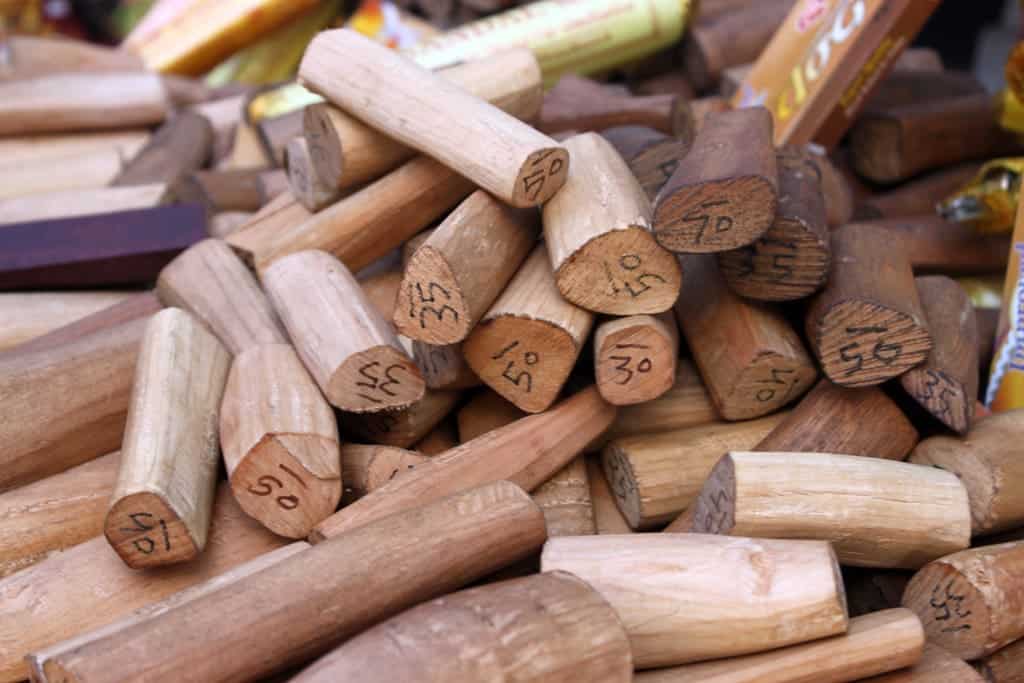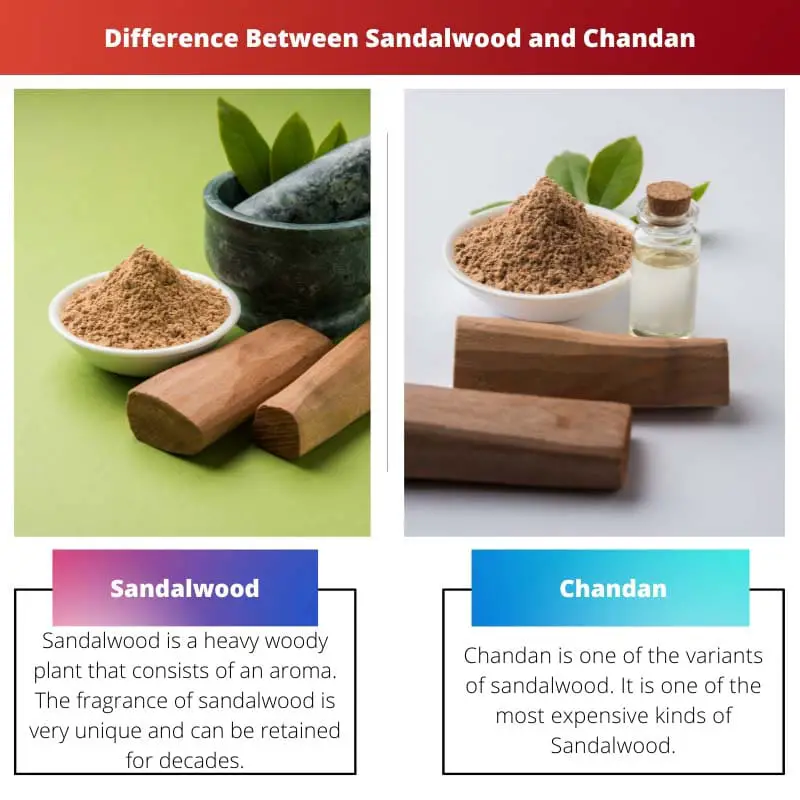Wood is the most important part of the tree. Because it is used for many purposes from construction to making furniture to using it for medicinal purposes.
Wood has been very useful to mankind because it gives many things to them. Wood is given by trees.
They act as a support system for trees giving them life by supplying nutrients and water to every other part. Wood consists of rings when they are cut it is visible. Rings tell us about the age of a tree.
Sandalwood and Chandan are the most expensive type of wood that is being sold at a very high price.
Key Takeaways
- Sandalwood and Chandan are the same fragrant wood from the Santalum genus trees, while agarwood comes from Aquilaria and Gyrinops.
- Sandalwood has a warm, creamy, and smooth fragrance, whereas agarwood has a rich, complex, deep aroma.
- Sandalwood has medicinal properties and is used in various beauty products, while agarwood is valued for its rarity and is primarily used in the perfume industry.
Sandalwood vs Chandan
The difference between Sandalwood and Chandan is that Sandalwood belongs to the family of Santalum. It incorporates all kinds of sandalwood under it.
On the other hand, Chandan is one of the varieties of Sandalwood also known as Indian sandalwood or Red Sandalwood because of its red colour.
Sandalwood is found everywhere around the world. Even cultivation is also done. But Chandan is only found in the southern region of India.

Sandalwood is a heavy woody plant that consists of an aroma. The fragrance of sandalwood is very unique and can be retained for decades. Sandalwood takes a lot of time to grow.
Even in the modern-day, harvesting and cultivation is also done in different parts of the world. Because of high demand and overharvesting its growth has suffered sometimes.
Sandalwood is a hemiparasitic plant and is mostly found in Indian subcontinents like Australia, Bangladesh, Hawaii, Sri Lanka, Indonesia and some parts of the Pacific Islands.
Chandan is one of the variants of sandalwood. It is one of the most expensive kinds of Sandalwood. Culturally, Chandan plays an important role in Hinduism, Buddhism and Janiosim.
It is found in India in the Eastern Ghats of Andhra Pradesh. Chandan comes under the category of endangered species in the IUCN list. Because it is overly exploited.
Chandan is a tropical tree that requires a warm climate and a lot of sunlight. It takes up to 25 to 30 years for the Chandan tree to develop fully.
Comparison Table
| Parameters of Comparison | Sandalwood | Chandan |
|---|---|---|
| Native | Indian subcontinents and Pacific regions | Eastern Ghats of Andhra Pradesh. |
| Soil | Can survive in any type of soil. | 6.5 – 7.5 pH |
| Height | 5 to 8 metres | 4 metres to 10 metres |
| Type | Deciduous Tree, evergreen etc | tropical |
| Uses | Sandalwood Oil, sandalwood Powder, soaps, face packs etc. | Beauty products, curing ailments, fragrance, sacred in religion, candles etc |
| Time | 10-15 years | 25-30 years |
What is Sandalwood?
Sandalwood is a deciduous tree that is used for many purposes. Sandalwood oil is very famous because of its fragrance. Sandalwood is used for therapeutic and aromatic purposes.
The fragrance of Sandalwood is very unique and even last longer. Ut some of the variants of sandalwood doesn’t have a fragrance. Sandalwood is extensively used in the cosmetic industry.
Sandalwood is found majorly in India and South Asian countries. Sandalwood belongs to the species of santalum album that is considered as the major factor.
Sandalwood has more than 19 species present. It is available in four variants. Sandalwood is now being used in technology as well because of its low fluorescence and optical refractive index.
Sandalwood is eaten by the aboriginals of Australia. They truly make jam, pies, chutneys from the fruit of sandalwood.
Sandalwood is overly exploited in India which has led to its decline. At the current time, Australia has become one of the largest producers of sandalwood. It supplies almost 80 per cent of Sandalwood.
It is one of the most expensive woods and the profit level is very high. So it is now harvested by removing the tree.

What is Chandan?
Chandan also called Indian sandalwood is a tropical tree. It is different from the usual sandalwood tree. The Woods of Chandan are heavy and yellow coloured.
They also have fragrances. Chandan can live up to 100 years. Chandan is a parasitic plant meaning that it can live with another tree without causing any harm to the host tree.
The Colour of Chandan varies from pale green to white and red. Chandan has two variants one is white and the other is Red also called Lal Chandan.
The word Chandan is derived from a Sanskrit word meaning wood that is used for burning purposes like incense sticks. Chandan has been used in India for thousands of years.
In the English language, it appeared in the 14th and 15th centuries during the Medieval Latin period.
Chandan also means something that is shining and glowing. Leaves of Chandan are thin. It takes three years to develop fruit on Chandan.
If we talk about growing into a large tree, then Chandan requires 25 to 30 years to grow completely. Red Chandan is not at all fragrant. Chandan needs a warm temperature and climate.
It needs alkaline soil having a pH value between 6 to 8. In religion, Chandan is very sacred. It is also used for the treatment of many types of diseases.

Main Differences Between Sandalwood and Chandan
- Sandalwood is native to South Asian countries and the Pacific regions. Chandan is a native of the Eastern Ghats of Andhra Pradesh, Karnataka and Tamil Nadu.
- Sandalwood can survive in any type of soil. Chandan grows in alkaline soil having a pH value between 6.5 to 7.5.
- The average height of sandalwood is between 5 to 8 metres. The average height of Chandan is 4 to 10 metres.
- Sandalwood is an evergreen deciduous tree. Chandan is a tropical tree.
- Uses of Sandalwood include Sandalwood Oil, sandalwood Powder, soaps, face packs etc. Uses of Chandan includes Beauty products, curing ailments, fragrance, sacred in religion, candles etc.
- Sandalwood grows in 10 to 15 years. Chandan takes a lot of time to develop 25 to 30 years. Even fruits grow after 3 years.

- https://link.springer.com/content/pdf/10.1007/1-4020-2985-3_39.pdf
- https://www.myupchar.com/en/tips/chandan-benefits-for-skin-in-hindi
